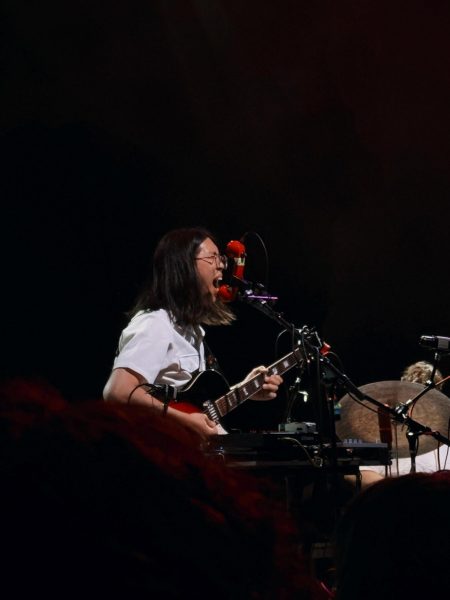An invitation to the wild party
“Queenie was a blonde and her age stood still,
And she danced twice a day in vaudeville.
Grey eyes.
Lips like coals aglow.
Her face was a tinted mask of snow.
What hips —
What shoulders —
What a back she had!
Her legs were built to drive men mad.
But sooner or later they bored her:
Sixteen a year was her order.”
-Joseph Moncure March, 1928
The audience awaits the performance. The entire musical takes place in a New York apartment.
When Carrie J. Sayer’s friends saw the amount of bright pink blush she was wearing, they thought it was a little much. But that is exactly what “The Wild Party,” a musical which highlights the excesses of the Jazz Age, calls for. Over the top.
The musical, which debuted on Broadway in 1999, is based on the book-length 1928 poem “The Wild Party” by Joseph March. The poem, which contains references to lust and violence was banned in most places because its content was considered too scandalous for its readers. The narrative follows Queenie, a vaudeville dancer, and her lover, a violent clown named Burrs, in the days of prohibition.
In 1997, Andrew Lippa wrote music for “The Wild Party,” bringing it into the public eye. Starting in late Aug. of 2018, “The Wild Party” has been playing at the Dionysus Theatre-popularly known as the Dio- in Pinckney Michigan.
Sayer plays Dolores, a washed-up prostitute. “My director gave me a certain physicality with her, which was to stumble a bit and look really, really tired and worn out,” Sayer said. “So anytime that Dolores is standing next to somebody, she basically drapes on them for support. And if she stops for a minute, she basically drops.”
Many of the characters in “The Wild Party” take on this mix of excess and enthusiasm while keeping a thinly veiled darker side. The lyrics to the songs show this in abundance “By morning, we could be dead drunk…” sings Burrs, “Or just dead.”
In the performance at the Dio, every female character except for Queenie, the main character, and Nadine, the only minor at the party, is dressed in a different shade of red. This adds to the tone of revelry and excess. The women in red all have a chance in the spotlight to party as hard as they can. In the end, their debauchery contributes to the tragic ending of the musical.
Though the show can be unsettling, the actors are all in agreement that the performance is vital.
“It’s important to tell these stories,” said Aurora Batton, who played Nadine, the minor.
“Sometimes stories translate better when you can see it in on the stage and relate to a character. It’s easier to understand the issue even though you might not be familiar with it. It validates people,” Her character is the only person in the musical who is uncomfortable with the behavior of the party goers. She serves to connect the audience to the action on stage.
The theatre was covered in deep purples and blacks. The notes piled over and around each other like boxers in the ring. The dancers remained in shadow until the just the right moment, when the steps crescendoed. Sayer’s blush was the least of the scandal.










